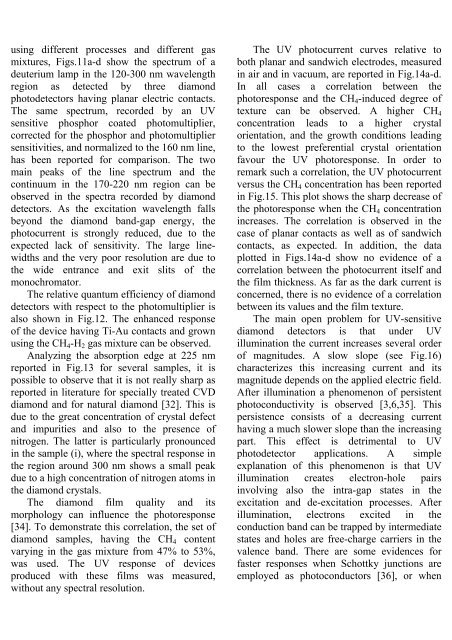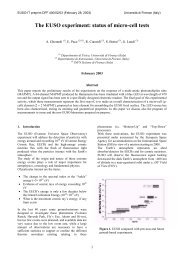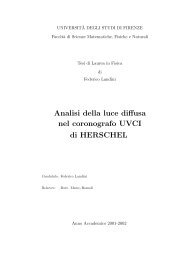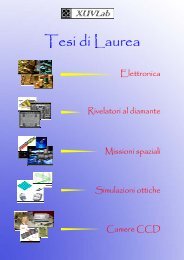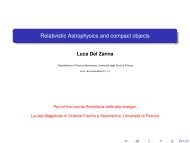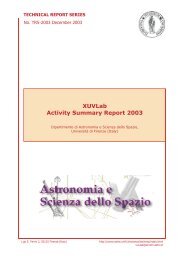Diamond-based UV and soft X-ray photodetectors E. Pace Dip. di ...
Diamond-based UV and soft X-ray photodetectors E. Pace Dip. di ...
Diamond-based UV and soft X-ray photodetectors E. Pace Dip. di ...
Create successful ePaper yourself
Turn your PDF publications into a flip-book with our unique Google optimized e-Paper software.
using <strong>di</strong>fferent processes <strong>and</strong> <strong>di</strong>fferent gasmixtures, Figs.11a-d show the spectrum of adeuterium lamp in the 120-300 nm wavelengthregion as detected by three <strong>di</strong>amond<strong>photodetectors</strong> having planar electric contacts.The same spectrum, recorded by an <strong>UV</strong>sensitive phosphor coated photomultiplier,corrected for the phosphor <strong>and</strong> photomultipliersensitivities, <strong>and</strong> normalized to the 160 nm line,has been reported for comparison. The twomain peaks of the line spectrum <strong>and</strong> thecontinuum in the 170-220 nm region can beobserved in the spectra recorded by <strong>di</strong>amonddetectors. As the excitation wavelength fallsbeyond the <strong>di</strong>amond b<strong>and</strong>-gap energy, thephotocurrent is strongly reduced, due to theexpected lack of sensitivity. The large linewidths<strong>and</strong> the very poor resolution are due tothe wide entrance <strong>and</strong> exit slits of themonochromator.The relative quantum efficiency of <strong>di</strong>amonddetectors with respect to the photomultiplier isalso shown in Fig.12. The enhanced responseof the device having Ti-Au contacts <strong>and</strong> grownusing the CH 4 -H 2 gas mixture can be observed.Analyzing the absorption edge at 225 nmreported in Fig.13 for several samples, it ispossible to observe that it is not really sharp asreported in literature for specially treated CVD<strong>di</strong>amond <strong>and</strong> for natural <strong>di</strong>amond [32]. This isdue to the great concentration of crystal defect<strong>and</strong> impurities <strong>and</strong> also to the presence ofnitrogen. The latter is particularly pronounce<strong>di</strong>n the sample (i), where the spectral response inthe region around 300 nm shows a small peakdue to a high concentration of nitrogen atoms inthe <strong>di</strong>amond crystals.The <strong>di</strong>amond film quality <strong>and</strong> itsmorphology can influence the photoresponse[34]. To demonstrate this correlation, the set of<strong>di</strong>amond samples, having the CH 4 contentvarying in the gas mixture from 47% to 53%,was used. The <strong>UV</strong> response of devicesproduced with these films was measured,without any spectral resolution.The <strong>UV</strong> photocurrent curves relative toboth planar <strong>and</strong> s<strong>and</strong>wich electrodes, measure<strong>di</strong>n air <strong>and</strong> in vacuum, are reported in Fig.14a-d.In all cases a correlation between thephotoresponse <strong>and</strong> the CH 4 -induced degree oftexture can be observed. A higher CH 4concentration leads to a higher crystalorientation, <strong>and</strong> the growth con<strong>di</strong>tions lea<strong>di</strong>ngto the lowest preferential crystal orientationfavour the <strong>UV</strong> photoresponse. In order toremark such a correlation, the <strong>UV</strong> photocurrentversus the CH 4 concentration has been reporte<strong>di</strong>n Fig.15. This plot shows the sharp decrease ofthe photoresponse when the CH 4 concentrationincreases. The correlation is observed in thecase of planar contacts as well as of s<strong>and</strong>wichcontacts, as expected. In ad<strong>di</strong>tion, the dataplotted in Figs.14a-d show no evidence of acorrelation between the photocurrent itself <strong>and</strong>the film thickness. As far as the dark current isconcerned, there is no evidence of a correlationbetween its values <strong>and</strong> the film texture.The main open problem for <strong>UV</strong>-sensitive<strong>di</strong>amond detectors is that under <strong>UV</strong>illumination the current increases several orderof magnitudes. A slow slope (see Fig.16)characterizes this increasing current <strong>and</strong> itsmagnitude depends on the applied electric field.After illumination a phenomenon of persistentphotoconductivity is observed [3,6,35]. Thispersistence consists of a decreasing currenthaving a much slower slope than the increasingpart. This effect is detrimental to <strong>UV</strong>photodetector applications. A simpleexplanation of this phenomenon is that <strong>UV</strong>illumination creates electron-hole pairsinvolving also the intra-gap states in theexcitation <strong>and</strong> de-excitation processes. Afterillumination, electrons excited in theconduction b<strong>and</strong> can be trapped by interme<strong>di</strong>atestates <strong>and</strong> holes are free-charge carriers in thevalence b<strong>and</strong>. There are some evidences forfaster responses when Schottky junctions areemployed as photoconductors [36], or when


